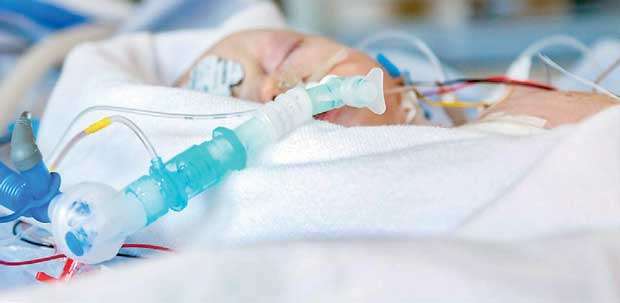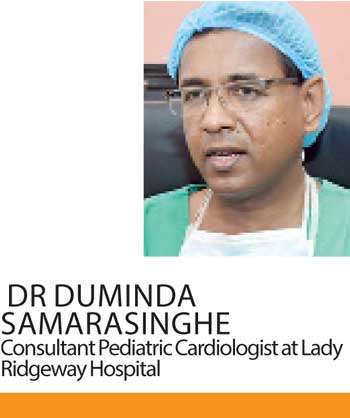20 Jul 2018 - {{hitsCtrl.values.hits}}

 A congenital heart defect, also known as a congenital heart anomaly or congenital heart disease, is a problem in the structure of the heart, which is present at birth. There are many types of congenital heart diseases and the most common defects involve the walls and the valves of the heart as well as large blood vessels that carry blood to and from the heart. They range from simple conditions that don’t cause symptoms to complex problems that cause severe, life-threatening symptoms and they fall mainly under these categories like: Holes in the heart, obstructed blood flow, abnormal blood vessels, Heart valve abnormalities and an underdeveloped heart.
A congenital heart defect, also known as a congenital heart anomaly or congenital heart disease, is a problem in the structure of the heart, which is present at birth. There are many types of congenital heart diseases and the most common defects involve the walls and the valves of the heart as well as large blood vessels that carry blood to and from the heart. They range from simple conditions that don’t cause symptoms to complex problems that cause severe, life-threatening symptoms and they fall mainly under these categories like: Holes in the heart, obstructed blood flow, abnormal blood vessels, Heart valve abnormalities and an underdeveloped heart.
Health Capsule got in touch with Dr Duminda Samarasinghe, Consultant Pediatric Cardiologist at Lady Ridgeway Hospital to shed light on the subject.
“There are many types of congenital heart defects. Most of these defects occur due to abnormal formation of the heart during fetal development, thus resulting in anomalies in the heart. In most cases the cause is unknown, but there are various factors that may contribute to this condition.
If you have a parent or a sibling who has been diagnosed with a congenital heart disorder, then the risk increases upto 10%
If you take the general population into consideration, there is a 1% risk of being diagnosed with a congenital heart disease. If you have a parent or a sibling who has been diagnosed with a congenital heart disorder then the risk increases up to 10%. Although the reason defects occur is presumed to be genetic, only a few genes have been discovered that are linked with causing heart defects.
Six to eight in a thousand newborns are diagnosed with congenital heart disorders annually. Factors that determine the prognosis of a patient diagnosed with a congenital heart defect could vary as it depends on the severity of the condition” he said.
The symptoms of a congenital heart defect may not appear until shortly after birth. Newborns with heart defects may experience symptoms like: having a pale, grey or blue skin colour, develop rapid breathing, have swelling in abdomen, legs or areas around the eyes, experience shortness of breath during feedings, and gain weight poorly.
Dr Samarasinghe further said, “Although many children with congenital heart defects don’t require treatment, the treatment depends on the type and severity of the defect. The most common defects identified are, ASD (Atrial Septal Defect), which occurs in the two upper chambers in the heart and VSD (Ventricular Septal Defect) which occurs in the two lower chambers in the heart”.
 There are two main types of treatment when it comes to congenital heart disorders. Catheter procedure is an interventional procedure which is a non-surgical treatment used to open narrowed coronary arteries to improve blood flow to the heart. An open heart surgery may be needed if catheter procedures aren’t enough to repair complex heart defects. Congenital heart diseases can be classified as either Cyanotic congenital heart disease, which causes low levels of oxygen in the blood, or Acyanotic congenital heart disease. In both types, the heart isn’t pumping blood as efficiently as it should.
There are two main types of treatment when it comes to congenital heart disorders. Catheter procedure is an interventional procedure which is a non-surgical treatment used to open narrowed coronary arteries to improve blood flow to the heart. An open heart surgery may be needed if catheter procedures aren’t enough to repair complex heart defects. Congenital heart diseases can be classified as either Cyanotic congenital heart disease, which causes low levels of oxygen in the blood, or Acyanotic congenital heart disease. In both types, the heart isn’t pumping blood as efficiently as it should.
“A cyanotic heart defect is a group type of congenital heart defect that occurs when the blood that has been pumped into the body contains a less-than-normal amount of oxygen. It causes a blue discolouration of the skin. The most common cyanotic heart defect is TOF (Tetralogy of Fallot)” he said.
In some cases, symptoms of a congenital heart defect may not appear until many years after birth. Once symptoms do develop, they may include: Abnormal heart rhythms, tiring quickly upon exertion, swelling of body tissues or organs, a bluish tint to the skin, lips and fingernails, fainting and dizziness.
A congenital heart disease won’t necessarily prevent a child from leading a normal life. The sooner they get medical attention, the better the chances for complete recovery. Regardless of the type of the defect, follow-up care is essential. Treatment may not completely cure the condition, but regular medical follow-ups and physical activity are extremely important when it comes to maintaining good health.
22 Dec 2024 3 hours ago
22 Dec 2024 3 hours ago
22 Dec 2024 5 hours ago
22 Dec 2024 6 hours ago
22 Dec 2024 6 hours ago